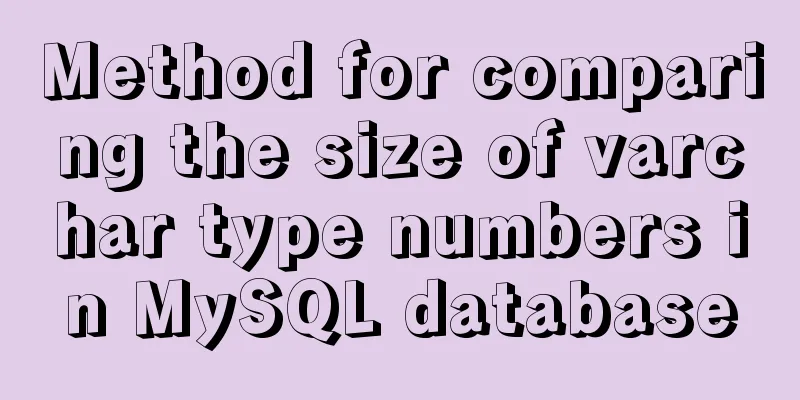Method for comparing the size of varchar type numbers in MySQL database

Create a test table
-- ----------------------------
-- Table structure for check_test
-- ----------------------------
DROP TABLE IF EXISTS `check_test`;
CREATE TABLE `check_test` (
`id` int(11) NOT NULL AUTO_INCREMENT,
`current_price` varchar(10) NOT NULL,
`price` varchar(10) NOT NULL,
PRIMARY KEY (`id`)
) ENGINE=InnoDB AUTO_INCREMENT=9 DEFAULT CHARSET=utf8;
-- ----------------------------
-- Records of check_test
-- ----------------------------
INSERT INTO `check_test` VALUES ('1', '12', '14');
INSERT INTO `check_test` VALUES ('2', '22', '33');
INSERT INTO `check_test` VALUES ('3', '15', '8');
INSERT INTO `check_test` VALUES ('4', '9', '7');
INSERT INTO `check_test` VALUES ('5', '12', '12.9');
We execute the following SQL: -- Find the records where current_price is smaller than price select * from check_test where current_price<price; select * from check_test where (current_price+0)<(price+0); -- Find the records where current_price is greater than price select * from check_test where current_price>price; select * from check_test where (current_price+0)>(price+0); The results are as follows:
We can see that in result 1 , 15>8 does not meet the condition but is found, while in result 3, 15>8 meets the condition but is not found. Why is this? Because the comparison of string type numbers starts from the first digit and compares the corresponding value in the character code. If they are equal, continue to compare the second digit. If they are not equal, the larger value is compared . The ASCII code values corresponding to the numeric characters are as follows:
For example:
We can verify this through code, using JavaScript: var current_price = "12"; var price = "14"; console.log(current_price < price); // true var current_price = "15"; var price = "8"; console.log(current_price < price); // true Therefore, numbers that may need to be compared should not be set to varchar type. However, if they have been set to varchar type, then if you want to compare them, convert them to numeric type for comparison and add 0 to the field in SQL. If it is a programming language, it needs to be converted through the corresponding function, and cannot be converted directly by adding 0, such as JavaScript: var current_price = "12"; var price = "14"; console.log(parseInt(current_price) < parseInt(price)); // true var current_price = "15"; var price = "8"; console.log(parseInt(current_price) < parseInt(price)); // false Note: The decimal value corresponding to the character is related to its encoding, but the ASCII code is compatible. Reference Links:Comparison of numbers of string type Comparison of VARCHAR type strings Comparing the size of numbers of varchar type This is the end of this article about how to compare the size of varchar numbers in MySQL database. For more information about comparing the size of MySQL varchar numbers, please search 123WORDPRESS.COM's previous articles or continue to browse the following related articles. I hope you will support 123WORDPRESS.COM in the future! You may also be interested in:
|
<<: How to try to add sticky effect to your CSS
>>: Detailed explanation of command to view log files in Linux environment
Recommend
Teach you the detailed process of using Docker to build the Chinese version of gitlab community
1. Use Docker Compose to configure startup If you...
Detailed explanation of the marquee attribute in HTML
This tag is not part of HTML3.2 and is only suppo...
Detailed explanation of Nginx forwarding socket port configuration
Common scenarios for Nginx forwarding socket port...
MySQL 4 common master-slave replication architectures
Table of contents One master and multiple slaves ...
Personalized and creative website design examples (30)
Therefore, we made a selection of 30 combinations ...
3 common errors in reading MySQL Binlog logs
1. mysqlbinlog: [ERROR] unknown variable 'def...
How to insert weather forecast into your website
We hope to insert the weather forecast into the w...
Detailed analysis of SQL execution steps
Detailed analysis of SQL execution steps Let'...
MySQL join buffer principle
Table of contents 1. MySQL join buffer 2. JoinBuf...
Solution to the problem of mysql master-slave switch canal
After configuring VIP, the error message that app...
MySql uses skip-name-resolve to solve the problem of slow external network connection client
The MySQL built on Tencent Cloud is always very s...
How to configure Nginx to split traffic based on the last segment of the request IP
It is mainly the configuration jump of the if jud...
MySQL 8.0.15 winx64 decompression version installation and configuration method graphic tutorial
This article shares the installation and configur...
XHTML introductory tutorial: text formatting and special characters
<br />This section introduces how to impleme...
How to uninstall MySQL 5.7.19 under Linux
1. Find out whether MySQL was installed before Co...













